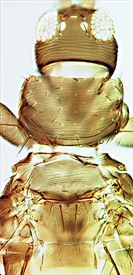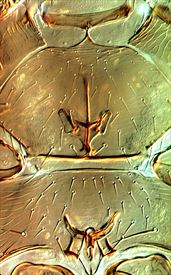Distinguishing features
Both sexes fully winged. Female brown, tarsi and apices of fore tibiae yellow; antennal segment III yellow; fore wings brown with base paler. Antennae 8-segmented. Head with ocellar setae III arising outside triangle; postocular setae I as long as ocellar setae III, postocular setae II about half as long as I. Pronotum with transverse markings, one pair of sublateral setae stouter than remaining discal setae. Mesonotum with lines of sculpture close to anterior campaniform sensilla. Metanotum transversely striate on anterior half, with longitudinal but more widely spaced striations on posterior half, median setae arise at anterior margin, campaniform sensilla present. Fore wing first vein with setal row variable, basal series with 9–12 then 2 or 3 near wing apex; clavus with subterminal seta shorter than terminal seta. Abdominal tergite II with 4 lateral setae; tergite VIII comb complete but short and irregular. Sternites III–VII with 14–18 discal setae; pleurotergites with discal setae varying from 0 to 3.
Male brown; pleurotergites usually with no discal setae; sternites III–VII with broad pore plate.
Related species
The genus Thrips includes 13 species from New Zealand, out of a total of 280 species worldwide (Mound & Masumoto, 2005). Many of these species have the antennae clearly 7-segmented, whereas others have 8 segments. All members of Thrips genus have paired ctenidia on the tergites, and on tergite VIII these are postero-mesad to the spiracles, and they also lack ocellar setae pair I in front of the first ocellus. In contrast, Frankliniella species have ctenidia on tergite VIII antero-lateral to the spiracles, and a pair of setae is always present in front of the first ocellus. Despite the presence of pleurotergal discal setae, T. novocaledonensis appears to be closely related to T. hawaiiensis on the basis of most of its structural characters, particularly the metanotum.
Biological data
Apparently polyphagous, adults of this flower-living species have been taken from various herbs and shrubs.
Distribution data
Not recorded from New Zealand, but considered a high risk potential invader. This species was described from New Caledonia, and is known from Vanuatu. It is particularly abundant on Norfolk Island in the flowers of a very wide range of unrelated plants (Mound & Wells, 2015), but is not known from continental Australia.
Family name
THRIPIDAE, THRIPINAE
Species name
Thrips novocaledonensis (Bianchi)
Original name and synonyms
Taeniothrips novocaledonensis Bianchi, 1945: 270
References
Mound LA & Masumoto M (2005) The genus Thrips (Thysanoptera, Thripidae) in Australia, New Caledonia and New Zealand. Zootaxa 1020: 1–64.
Mound LA, Tree DC & Paris D (2012) OzThrips – Thysanoptera in Australia. http://www.ozthrips.org/
Mound LA & Wells A (2015) Endemics and adventives: Thysanoptera (Insecta) Biodiversity of Norfolk, a tiny Pacific Island. Zootaxa 3964 (2): 183–210.




